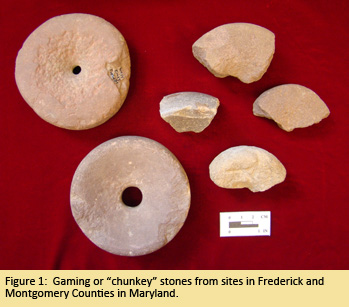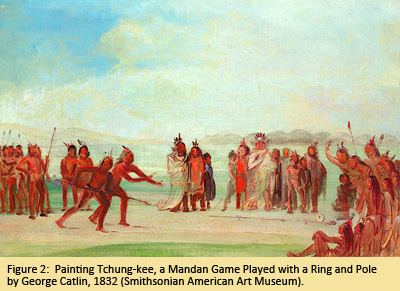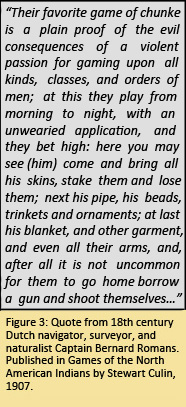Native American Gaming Stones
January 2011
By Rebecca Morehouse, MAC Lab State Curator
 Games have always been an integral part of human culture. Throughout history, games have been used to teach new skills, provide an escape from the rigors and stress of daily life, as well as to solidify social and political bonds within a particular group, clan, or tribe.
Games have always been an integral part of human culture. Throughout history, games have been used to teach new skills, provide an escape from the rigors and stress of daily life, as well as to solidify social and political bonds within a particular group, clan, or tribe.
Native American cultures have a long tradition of gaming. Early European accounts of contact with Native Americans describe a variety of games. Many required physical skill and dexterity, such as ball games -- e.g. Lacrosse -- or snow-snake, a spear throwing game played on the ice or snow (George 2001: 1). Others were games of chance, such as the “moccasin game”, similar to the ball and cup game still popular today, or “dice” games played with an assortment of stones or seeds marked with notches or pictures (Hudson 1976: 426).
 One of the most popular, games among Native American tribes was called “chunkey” (or, alternatively, “chunkee or “t-chung-kee”), which was played with polished, disc-shaped stones (Figure 1). Chunkey stones have convex edges and concave sides and were occasionally perforated in the center. Played by men on courts of smooth, hard packed dirt, chunkey was a two player version of a hoop and stick game (Figure 2). It was played by rolling the chunkey stones across the ground and throwing or sliding sticks at them in an attempt to place the spear as close to where the stone stops as possible (Hudson 1976: 423).
One of the most popular, games among Native American tribes was called “chunkey” (or, alternatively, “chunkee or “t-chung-kee”), which was played with polished, disc-shaped stones (Figure 1). Chunkey stones have convex edges and concave sides and were occasionally perforated in the center. Played by men on courts of smooth, hard packed dirt, chunkey was a two player version of a hoop and stick game (Figure 2). It was played by rolling the chunkey stones across the ground and throwing or sliding sticks at them in an attempt to place the spear as close to where the stone stops as possible (Hudson 1976: 423).
 For the players, chunkey was a game of skill. However, for the spectators, it was a game of chance, as they frequently bet on the game, with some wagering everything they owned on the outcome. They were even known to bet their wives, children or their own freedom. Some losers were even known to commit suicide (Figure 3).
For the players, chunkey was a game of skill. However, for the spectators, it was a game of chance, as they frequently bet on the game, with some wagering everything they owned on the outcome. They were even known to bet their wives, children or their own freedom. Some losers were even known to commit suicide (Figure 3).
Chunkey is believed to have originated around 600 A.D. in the ancient Native American city of Cahokia, in the area of now modern day St. Louis, Missouri (Pauketat 2009: 54). In Cahokia, chunkey was played in large arenas and brought together people from the surrounding region. Even after the city of Cahokia fell in c. 1500 A.D., variations were played throughout North America. Some Native American tribes continued playing the chunkey game long after European contact, as witnessed by the artist George Catlin in 1832 (Figure 2).
In Maryland’s archaeological collections, these stones (Figure 1), only seem to be found at sites in Frederick and Montgomery Counties. They are also rarely recovered from sites in Virginia (George 2001: 4). It is unclear whether the Middle Atlantic sites where chunkey stones have been recovered simply represent the outer limits of the game’s range, or if these stones may have had a use other than for gaming. Further research is necessary to understand why their distribution in the Middle Atlantic is not more widespread.
| References |
|
| Culin, Stewart |
| 1907 |
Games of the North American Indians. Twenty-fourth Annual Report of the Bureau of American Ethnology. Washington DC, Smithsonian Institution. |
|
| DeBoer, Warren R. |
| 1993 |
Like a Rolling Stone: The Chunkey Game and Political Organization in Eastern North America. Southeastern Archaeology 12 (2): 83-92. |
|
| George, Richard L. |
| 2001 |
"Of Discoidals and Monongahela: A League of Their Own?" in Archaeology of Eastern North America 29: 1-18. |
|
| Hudson, Charles |
| 1976 |
The Southeastern Indians. University of Tennessee Press. |
|
| Pauketat, Timothy R. |
| 2009 |
Cahokia: Ancient America’s Great City of the Mississippi. New York: Viking. |
|
| Smithsonian American Art Museum |
|
Electronic Document. http://americanart.si.edu/collections/search/artwork/?id=4407 accessed December 7, 2010. |
|